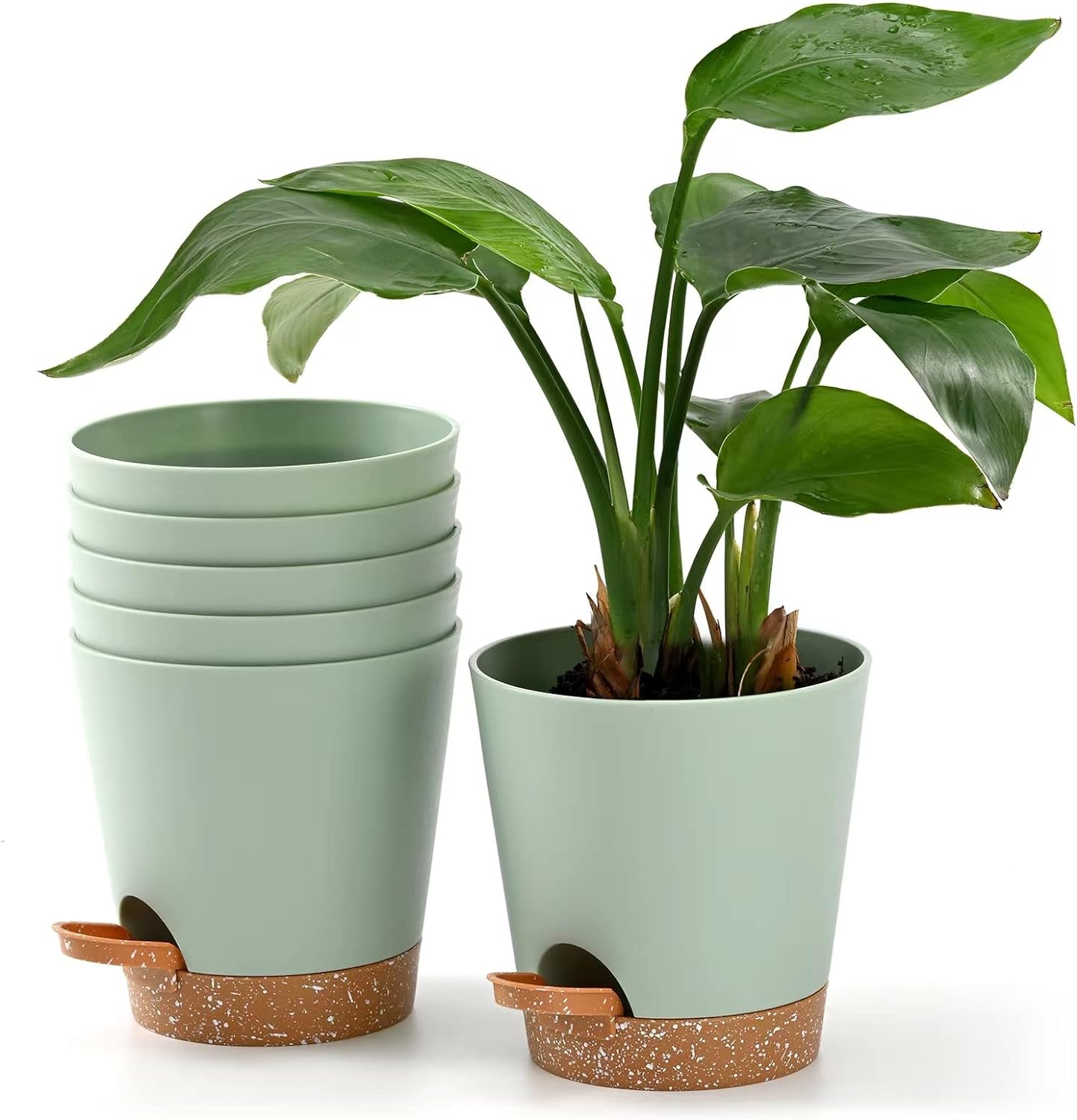Container gardening is a fantastic way to add a touch of life and beauty to any space, big or small. It’s perfect for those with limited outdoor areas like balconies or patios, and the portability allows you to create dynamic displays throughout your surroundings. Whether you’re a seasoned gardener or just starting out, container gardens offer a fun and rewarding way to explore the world of plants.
This guide showcases 13 stunning container garden ideas that cater to various aesthetics and functionalities. From cascading bursts of color to fragrant herb havens and miniature masterpieces, you’re sure to find inspiration for your own personal green oasis.
1. Self-Watering Hanging Planters: Convenience Meets Beauty
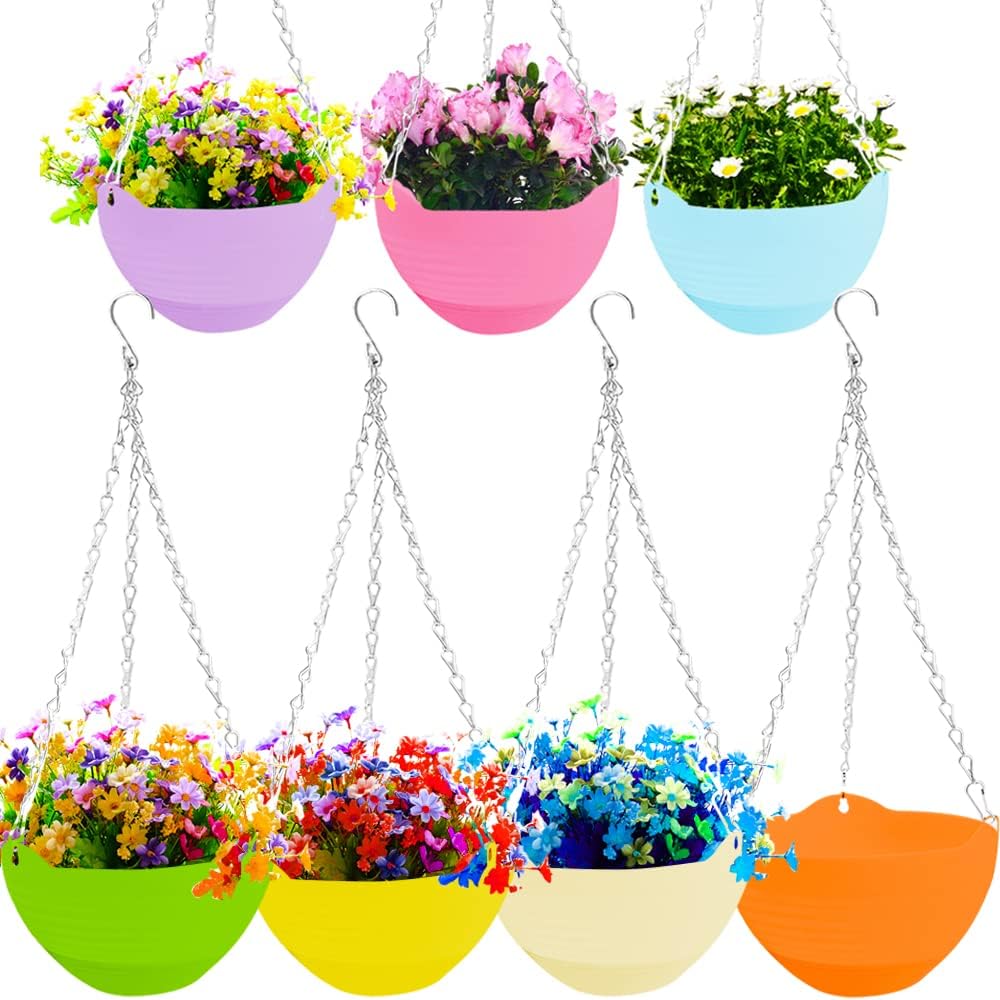
Self-watering hanging planters are a fantastic option for anyone who wants to enjoy the beauty of cascading flowers and lush greenery without the constant worry of over or underwatering. They combine the decorative appeal of hanging baskets with a built-in irrigation system, making them ideal for busy individuals or those new to gardening.
Here’s a breakdown of how they work:
- Double Reservoir System: These planters typically have two chambers. The top chamber houses your plants and potting mix. The bottom chamber acts as a water reservoir.
- Water Wicking: A separator divides the two chambers. This separator is made of a porous material like fabric or a wicks. Water from the reservoir is drawn upwards through the separator by capillary action, keeping the soil in the top chamber moist.
- Water Level Indicator: Many self-watering hanging planters come with a water level indicator. This is a transparent window or gauge on the side of the reservoir that allows you to see how much water is available to your plants.
Benefits of Self-Watering Hanging Planters:
- Reduced Watering Frequency: The biggest advantage is the reduced need for frequent watering. You only need to fill the reservoir periodically, depending on the size of the planter, plant type, and climate.
- Prevents Overwatering: Overwatering is a common issue with hanging planters, as the soil can dry out quickly. Self-watering planters eliminate this risk, as plants only take up the water they need.
- Consistent Moisture: The self-watering system ensures consistent moisture levels for your plants, promoting healthy growth and vibrant blooms.
- Convenience: These planters are perfect for busy schedules or forgetful gardeners. They offer peace of mind knowing your plants are getting the water they need.
- Beautiful Displays: Hanging planters add a vertical element to your porch, patio, or balcony. Self-watering options come in various styles and materials to complement your décor.
Things to Consider:
- Plant Selection: While self-watering planters work well for many plants, they might not be suitable for all. Plants with very specific moisture needs or those that require constantly soggy soil might not be ideal.
- Filling the Reservoir: Use filtered or rainwater whenever possible, especially for sensitive plants. Tap water can contain minerals that can build up in the reservoir over time.
- Monitor Water Levels: Even with a self-watering system, it’s still important to monitor the water level in the reservoir regularly. During hot weather or for plants with high water needs, you may need to refill more often.
- Drainage: While some self-watering planters have overflow holes to prevent excess water build-up, it’s a good idea to check if the one you choose has this feature.
Overall, self-watering hanging planters are a great way to add beauty and life to your outdoor space with minimal effort. They offer convenience, promote healthy plant growth, and come in a variety of styles to suit your taste.
2. Self-Watering Planters with Reservoir Trays: A Simple Solution for Healthy Plants
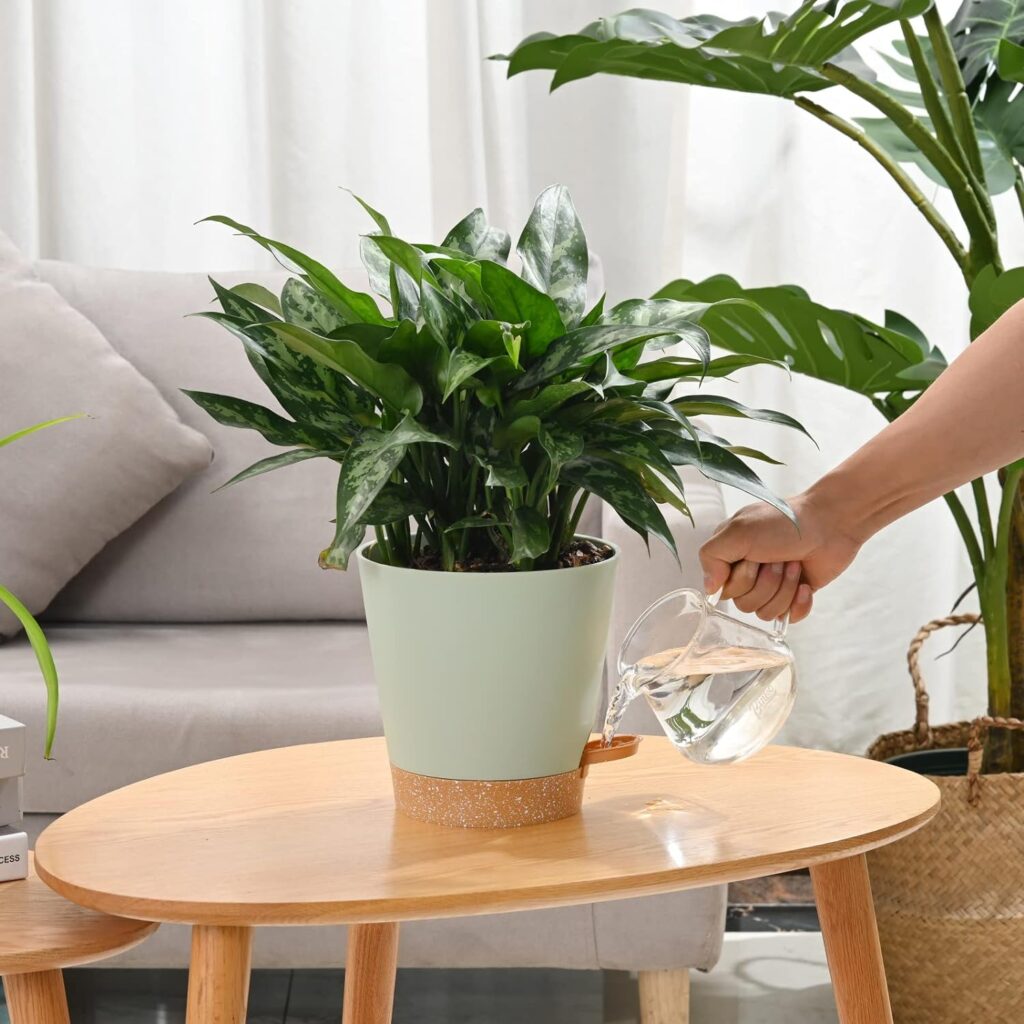
Self-watering planters with reservoir trays offer a convenient and low-maintenance approach to container gardening. These planters provide a self-sufficient watering system for your plants, making them ideal for busy individuals or those new to plant care.
Here’s a breakdown of how they work:
- Design: These planters consist of two main parts – a regular planter pot and a separate reservoir tray. The planter pot has drainage holes in the bottom, allowing excess water to drain. The reservoir tray sits beneath the planter pot and acts as a water reservoir.
- Watering Mechanism: There are two main ways water reaches the plant:
- Capillary Matting: Some planters use a capillary matting system. A fabric mat sits inside the planter pot, resting on the bottom and extending up the sides a few inches. The mat wicks water from the reservoir tray up into the potting mix, keeping the soil consistently moist.
- Water Level Indicator: Other planters may have a water level indicator built into the reservoir tray. This allows you to see the water level and refill the reservoir when needed. Plants absorb water directly from the reservoir through the drainage holes in the planter pot.
Benefits of Self-Watering Planters with Reservoir Trays:
- Reduced Watering Frequency: The biggest advantage is the reduced need for frequent watering. You only need to fill the reservoir periodically, depending on the size of the planter, plant type, and climate.
- Prevents Overwatering: Overwatering is a common issue with container gardening. These planters eliminate this risk, as excess water drains into the reservoir instead of pooling around the roots.
- Consistent Moisture: The self-watering system ensures consistent moisture levels for your plants, promoting healthy growth and vibrant blooms.
- Convenience: These planters are perfect for busy schedules or forgetful gardeners. They offer peace of mind knowing your plants are getting the water they need.
- Variety of Styles: Self-watering planters with reservoir trays come in various sizes, materials (plastic, ceramic, etc.), and colors to complement your décor.
Things to Consider:
- Plant Selection: While these planters work well for many plants, they might not be suitable for all. Plants with very specific moisture needs, like cacti or succulents, might not thrive in this system.
- Filling the Reservoir: Use filtered or rainwater whenever possible, especially for sensitive plants. Tap water can contain minerals that can build up in the reservoir over time.
- Monitor Water Levels: Even with a self-watering system, it’s still important to monitor the water level in the reservoir regularly. During hot weather or for plants with high water needs, you may need to refill more often.
- Overflow Drainage: Ensure the reservoir tray has adequate capacity to hold any excess water that drains from the planter pot. This prevents the plant from sitting in waterlogged soil.
- Salt Build-up: Over time, mineral salts can accumulate in the potting mix and reservoir. Occasionally flush the system with clean water to prevent this build-up.
Self-watering planters with reservoir trays offer a simple and effective way to keep your container plants healthy and thriving. They provide a balance between convenience and proper plant care, making them a great choice for gardeners of all experience levels.
3. Nonwoven Fabric Raised Garden Bed Planter Containers: A Flexible and Functional Option
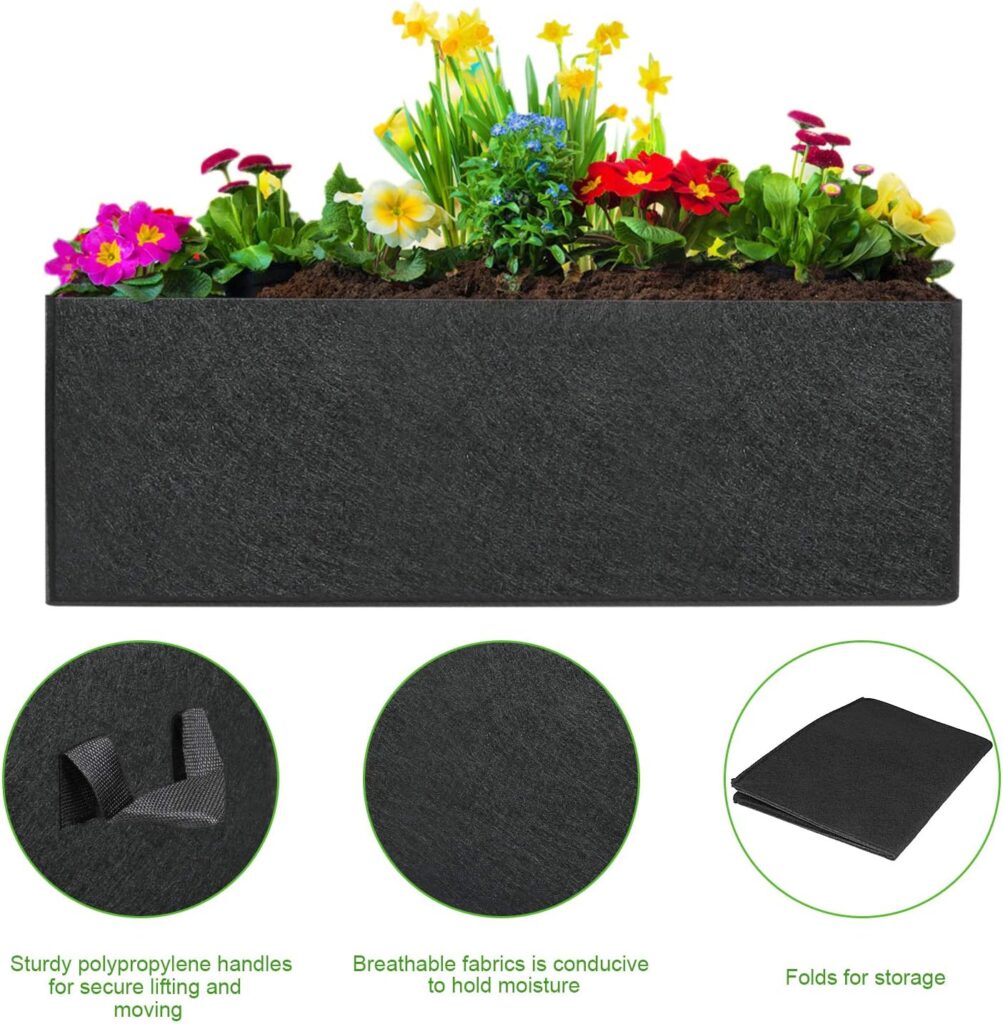
Nonwoven fabric raised garden bed planter containers offer a unique and versatile approach to container gardening. These planters are constructed from a breathable, lightweight material called nonwoven fabric, making them a great alternative to traditional rigid containers like wood, plastic, or ceramic.
Here’s a breakdown of the key features:
- Material: Nonwoven fabric is a synthetic material created by bonding together fibers without traditional weaving. It allows for air and water permeability while remaining durable and resistant to tearing.
- Raised Design: These containers come in various shapes and sizes, but all share the characteristic of raised beds. This elevation offers several benefits, including improved drainage, easier access for planting and harvesting, and reduced soil compaction.
- Flexibility: Unlike rigid containers, nonwoven fabric planters are flexible and conform to different shapes. This allows you to create unique garden layouts or fit them into tight spaces on balconies or patios.
- Lightweight: The fabric construction makes them lightweight and portable compared to traditional raised beds. This makes them easy to move around your garden or rearrange your planting scheme.
Benefits of Nonwoven Fabric Raised Garden Beds:
- Improved Drainage: The breathable fabric allows excess water to drain freely, preventing root rot, a common problem in container gardens.
- Soil Aeration: The fabric allows for better air circulation throughout the soil, promoting healthy root development for your plants.
- Warmer Soil Temperatures: The dark fabric can absorb heat from the sun, leading to slightly warmer soil temperatures, which can be beneficial for some plants, especially those with a preference for warmer climates.
- Weed Suppression: The fabric can help suppress weed growth within the planting area, reducing the need for weeding.
- Cost-Effective: Nonwoven fabric planters are generally less expensive than traditional raised garden beds made from wood or other materials.
- Easy to Set Up: These planters typically require minimal assembly and are easy to set up, even for beginners.
Things to Consider:
- Durability: While nonwoven fabric is reasonably durable, it may not last as long as some traditional raised bed materials like wood or brick. Expect to replace them every few years depending on use and weather conditions.
- Susceptibility to Wind: The lightweight nature of these planters can make them susceptible to being blown over in strong winds. Consider anchoring them down or placing them in a sheltered location.
- Temperature Extremes: The dark fabric can absorb heat, which can be beneficial in some climates but might lead to overheating for plants in very hot environments.
- Limited Aesthetics: The black fabric may not be the most aesthetically pleasing option for all gardens.
Overall, nonwoven fabric raised garden bed planter containers offer a functional and affordable solution for growing vegetables, herbs, or flowers in containers. Their breathability, lightweight design, and ease of use make them a great choice for beginner gardeners or those with limited space. However, their lifespan and potential for windblown mishaps are factors to consider.
4: Tomato Planter Boxes with Trellis: A Perfect Match for Climbing Vines
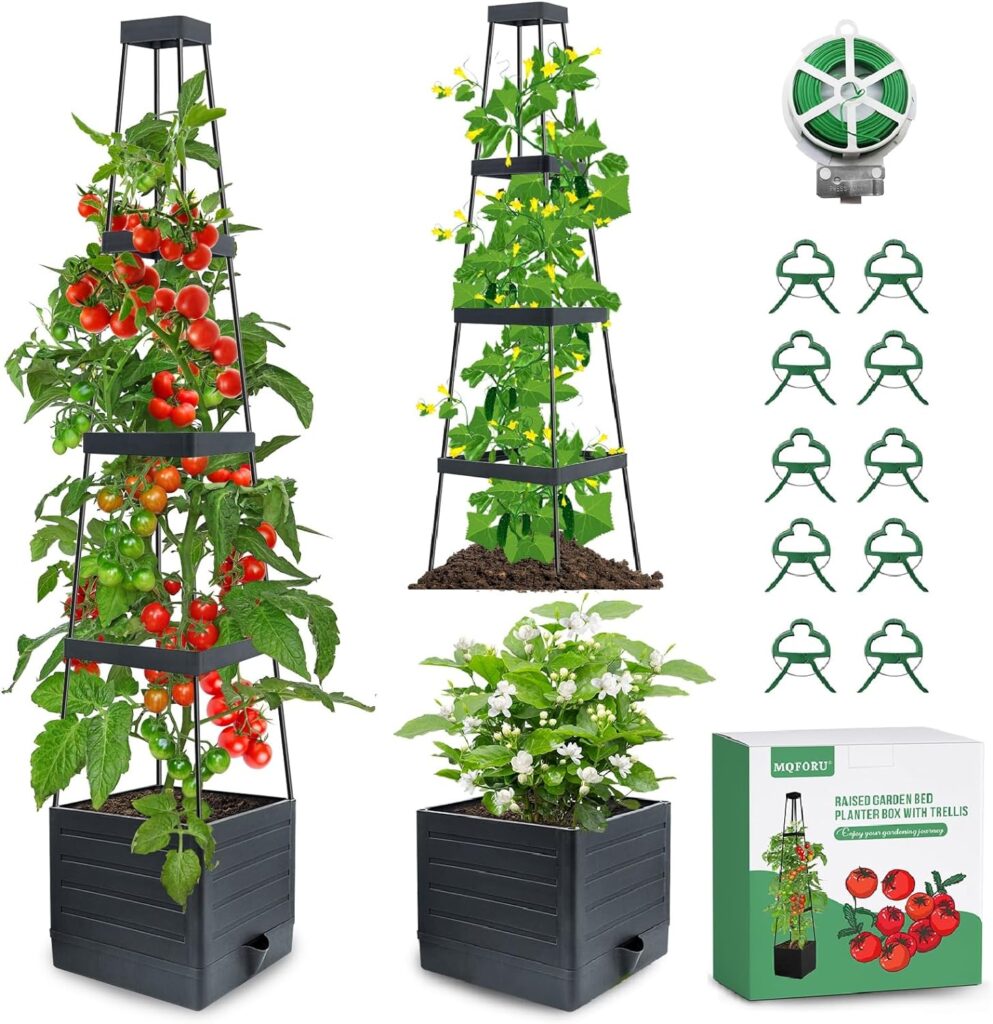
Tomato planter boxes with trellis are a dream combination for growing delicious tomatoes, especially for those with limited space. These containers provide a dedicated growing area for your tomatoes while offering essential support for their climbing vines.
Here’s a breakdown of the concept:
- Planter Box: These come in various materials like wood, plastic, or even fabric. Choose a size appropriate for the number of tomato plants you want to grow and ensure it has drainage holes to prevent waterlogging.
- Trellis: The trellis is a vertical structure that provides support for the tomato vines as they grow. Trellises for tomato planter boxes can be made from various materials like wood, metal, or even strong mesh. They can be attached directly to the planter box or be a separate structure positioned behind it.
Benefits of Tomato Planter Boxes with Trellis:
- Space-Saving: Planter boxes allow you to grow tomatoes even in areas with limited ground space, like balconies, patios, or rooftops. The trellis maximizes the use of vertical space by encouraging the vines to grow upwards.
- Improved Air Circulation: Good air circulation around the plants helps prevent fungal diseases, a common problem with tomatoes. The elevated position on the trellis promotes better air flow around the leaves and fruit.
- Stronger Plants and Easier Harvesting: The trellis provides support for the tomato vines, preventing them from sprawling or breaking under the weight of the fruit. This leads to healthier plants and makes harvesting easier as the tomatoes are more accessible.
- Increased Yield: Studies have shown that tomatoes grown on trellises can produce higher yields compared to those grown without support.
- Aesthetics: Tomato plants with cascading vines full of ripening tomatoes can be quite attractive. The combination of the planter box and trellis can add a touch of vertical greenery and visual interest to your space.
Things to Consider:
- Tomato Variety: Choose tomato varieties that are known to be indeterminate, meaning they have a vining growth habit and benefit from support. Determinate varieties, which are more compact and bush-like, don’t necessarily require a trellis.
- Trellis Size and Strength: Ensure the trellis is tall enough to accommodate the mature height of your chosen tomato variety. The trellis should also be sturdy enough to support the weight of the growing vines and ripening fruit.
- Staking and Training: While the trellis provides support, you may need to stake your tomato plants initially to guide them onto the trellis as they grow.
- Watering and Fertilizing: Tomato plants require consistent moisture, so be prepared to water your container garden regularly. Proper fertilization is also essential for healthy growth and fruit production.
Overall, tomato planter boxes with trellis are an excellent option for growing delicious tomatoes, especially in limited spaces. They provide the perfect combination of dedicated growing space, essential support for climbing vines, and several benefits that promote healthy plants and bountiful harvests.
5. Galvanized Raised Garden Bed Kit: A Sturdy and Stylish Option for Growing
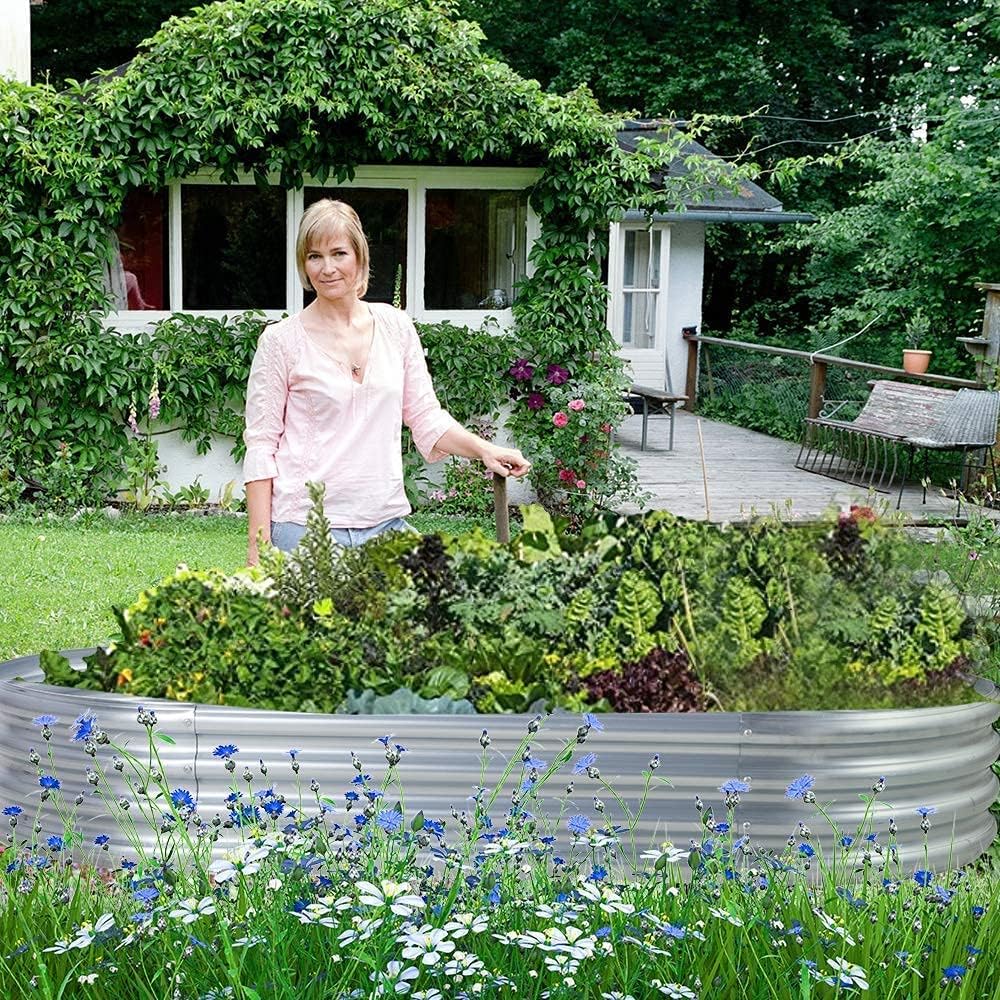
Galvanized raised garden bed kits offer a practical and attractive solution for container gardening. These kits provide everything you need to create a dedicated growing space for your vegetables, herbs, flowers, or even small shrubs.
Here’s a breakdown of the key features:
- Material: Galvanized steel is the defining characteristic of these kits. The steel is treated with a zinc coating (galvanization) to prevent rust and corrosion, making them durable and long-lasting for outdoor use.
- Raised Design: Similar to other raised garden beds, these kits come in various shapes and sizes but share the raised bed design. This elevation offers several benefits, including:
- Improved Drainage: Excess water can drain freely through the bottom of the bed, preventing root rot, a common problem in container gardens.
- Better Soil Temperature: The raised bed can warm up faster in the spring and retain heat better, which can be beneficial for some plants, especially those with a preference for warmer soil temperatures.
- Reduced Soil Compaction: The raised design helps prevent soil compaction, which can hinder root growth and plant health.
- Easier Access: The elevated bed makes it easier to plant, tend to, and harvest your plants, especially for those with bending or kneeling difficulties.
Components of a Galvanized Raised Garden Bed Kit:
- Pre-cut Galvanized Steel Panels: These interlocking panels form the walls of the raised bed. The kits typically come with easy-to-follow instructions for assembly, often not requiring any special tools.
- Reinforcement Braces: Some kits may include corner braces or other reinforcement components to ensure the structure’s stability, especially for larger raised beds.
- Hardware: Depending on the design, the kit may include screws, nuts, or bolts for fastening the panels together.
Benefits of Galvanized Raised Garden Beds:
- Durability: Galvanized steel is a strong and weather-resistant material, making these raised beds a long-lasting option for your garden.
- Easy Assembly: Most kits are designed for easy assembly, often requiring no special tools. The interlocking panels make for a quick and straightforward setup.
- Variety of Sizes and Styles: These kits come in a wide range of sizes and styles to suit your space and gardening needs. You can find options from small, compact beds ideal for balconies to larger, multi-level configurations suitable for growing a wider variety of plants.
- Improved Soil Quality: Raised beds allow you to control the soil quality, which is especially beneficial in areas with poor native soil conditions. You can fill the bed with a high-quality potting mix specifically suited for your chosen plants.
- Clean and Organized Appearance: The raised design and metal material create a clean and organized look in your garden. They can add a touch of modern style to your outdoor space.
Things to Consider:
- Size: Choose a raised bed size that is appropriate for your available space and the number of plants you want to grow.
- Weight: When filled with soil, these raised beds can become quite heavy. Consider placement and accessibility before setting them up.
- Drainage Holes: Ensure the kit includes drainage holes in the bottom panels to prevent waterlogging. Some kits may require drilling your own drainage holes.
- Soil Heating: In colder climates, the metal walls can absorb heat from the sun and radiate it back into the soil, which can be beneficial. However, in very hot climates, the metal can become quite hot and potentially affect heat-sensitive plants.
Galvanized raised garden bed kits offer a sturdy, stylish, and functional option for creating a dedicated growing space in your garden. Their ease of assembly, durability, and variety of sizes make them a popular choice for both novice and experienced gardeners.
6. AquaGarden Pond and Waterfall Kit Container Water Garden
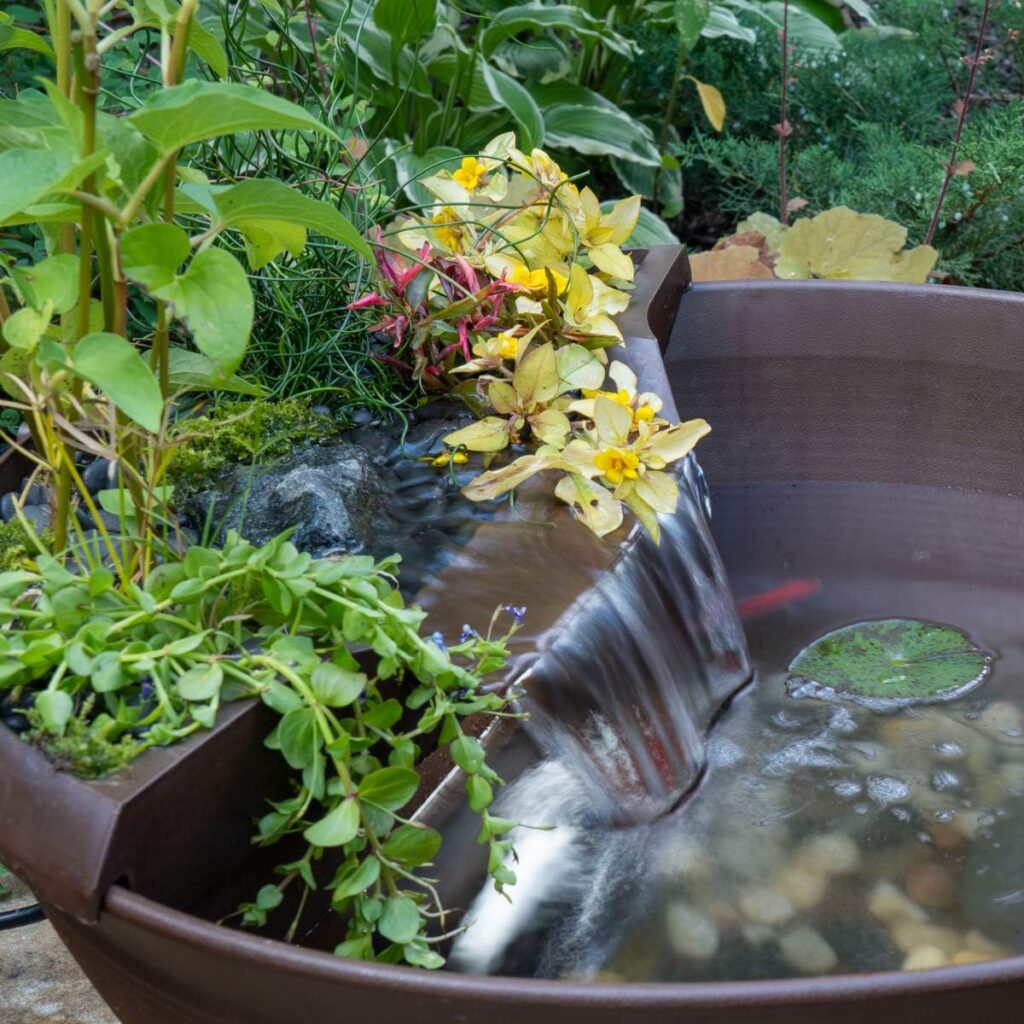
The AquaGarden Pond and Waterfall Kit Container Water Garden is a miniature water garden designed to bring the beauty and tranquility of water features to balconies, patios, decks, or even indoors. It’s a complete kit that provides everything you need to create a small, self-contained aquatic ecosystem.
Here’s a breakdown of the kit’s components and features:
- Container: Made from durable, injection-molded plastic, the container acts as the pond itself. It has a textured finish and comes in various colors (e.g., mocha, steel gray) to complement your outdoor space.
- Waterfall Feature: An integrated waterfall feature adds a touch of movement and sound to your water garden. A small pump circulates water from the lower pond area up to the top, creating a cascading waterfall effect.
- Biological Filter Media: The kit includes media specifically designed to promote healthy water quality. This media provides a surface area for beneficial bacteria to grow, which helps break down waste products and maintain a clear, healthy environment for fish and plants.
- Decorative Gravel: The kit also includes decorative gravel for both the base of the waterfall and the bottom of the pond. The gravel adds a natural aesthetic element and helps anchor plants while allowing for good water flow.
Benefits of the AquaGarden Pond and Waterfall Kit:
- Easy Setup: This kit is designed for quick and easy setup. Simply add the media, gravel, and water, and your mini pond is ready to go. No complex plumbing or electrical connections are required.
- Low Maintenance: The integrated waterfall and filter media help maintain good water quality, reducing the need for frequent cleaning or water changes.
- Relaxing Atmosphere: The sound of trickling water and the sight of gentle movement can create a peaceful and calming atmosphere in your outdoor space.
- Multiple Uses: This kit can be used to create a habitat for a small number of fish (consult the kit instructions for specific recommendations) or a haven for aquatic plants. You can even combine both for a miniature underwater ecosystem.
- Compact Size: The small size of this container water garden makes it ideal for balconies, patios, decks, or even indoors on a table or countertop.
Things to Consider:
- Limited Size: Due to its compact size, this kit is not suitable for large fish or extensive plant life. It’s best suited for a few small fish or a selection of aquatic plants.
- Water Maintenance: While the filter media helps, regular water monitoring and occasional top-offs or water changes might still be necessary, especially during hot weather.
- Sunlight Exposure: Choose a location that receives moderate sunlight throughout the day. Too much direct sun can promote algae growth, while insufficient light can hinder plant health.
- Winter Care: If using outdoors in colder climates, you may need to take steps to protect the pond and its inhabitants during freezing temperatures. Consult the manufacturer’s instructions for specific recommendations.
Overall, the AquaGarden Pond and Waterfall Kit Container Water Garden is a great option for anyone who wants to add a touch of tranquility and the beauty of water features to their space with minimal setup and maintenance. It’s perfect for creating a miniature aquatic oasis on a balcony, patio, or even indoors.
7. Raised Garden Bed with Legs Planters: Comfort and Convenience for Outdoor Gardening
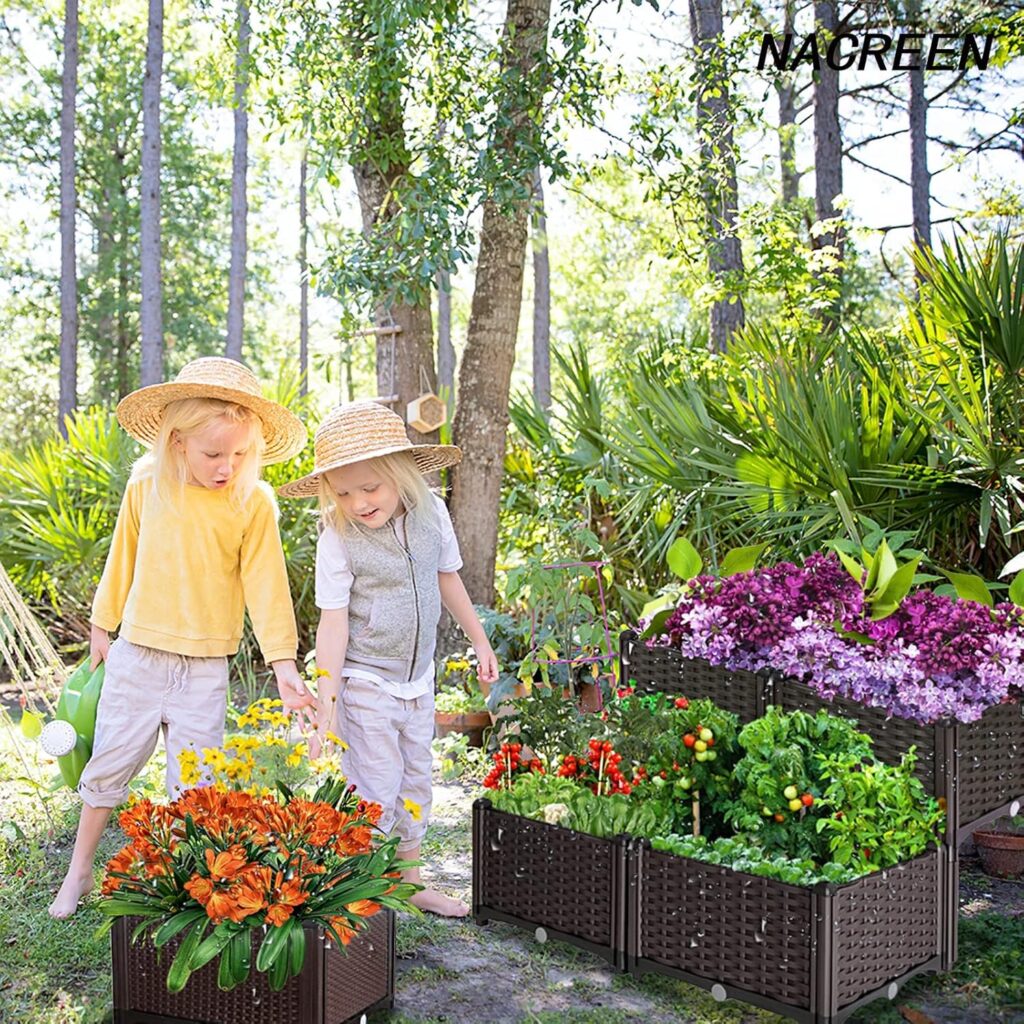
Raised garden beds with legs offer a unique and practical solution for container gardening outdoors. They combine the benefits of raised beds with the added advantage of elevation, making gardening more accessible and comfortable.
Here’s a breakdown of the key features:
- Raised Bed Design: Similar to traditional raised garden beds, these planters come in various shapes and sizes but share the elevated design. This elevation offers several benefits, including:
- Improved Drainage: Excess water can drain freely through the bottom of the bed, preventing root rot, a common problem in container gardens.
- Better Soil Temperature: The raised bed can warm up faster in the spring and retain heat better, which can be beneficial for some plants.
- Reduced Soil Compaction: The raised design helps prevent soil compaction, which can hinder root growth and plant health.
- Elevated on Legs: The key differentiating feature is the addition of legs that elevate the planting surface. This elevation provides several advantages:
- Reduced Back Strain: The raised planting surface reduces the need for excessive bending and kneeling, making gardening more comfortable for people with back problems or limited mobility.
- Easier Access: The elevated bed makes it easier to plant, tend to, and harvest your vegetables, herbs, or flowers.
- Improved Air Circulation: The space beneath the bed allows for better air circulation around the soil and plant base, which can help prevent fungal diseases.
Materials and Construction:
These raised garden beds with legs can be constructed from various materials, including:
- Wood: A popular choice due to its classic look and ease of customization. However, wood requires regular maintenance to protect it from the elements.
- Cedar: A naturally rot-resistant wood option that offers good durability outdoors.
- Recycled Plastic: A lightweight and low-maintenance option that is resistant to rot and weathering.
- Metal: Provides a sturdy and modern aesthetic but can heat up significantly in hot climates.
Many raised garden beds with legs come pre-assembled or require minimal assembly with easy-to-follow instructions.
Benefits of Raised Garden Beds with Legs:
- Comfort and Accessibility: The elevated design makes gardening more comfortable and accessible for people of all ages and abilities.
- Improved Plant Health: The benefits of raised beds like better drainage, soil temperature, and air circulation contribute to healthier plants.
- Versatility: These planters can be used to grow a wide variety of vegetables, herbs, flowers, or even small shrubs.
- Space Saving: They can be a good option for utilizing vertical space in patios or balconies.
- Aesthetics: Raised garden beds with legs can add a touch of style and definition to your outdoor space.
Things to Consider:
- Material: Choose a material that suits your budget, aesthetic preferences, and desired level of maintenance.
- Size: Select a size appropriate for your available space and the number of plants you want to grow.
- Weight Capacity: Consider the weight of the soil and plants when choosing a bed with legs, especially if it’s made from lighter materials like plastic.
- Drainage Holes: Ensure the raised bed has adequate drainage holes to prevent waterlogging. Some pre-made options may require drilling additional drainage holes.
- Sun Exposure: Position the raised bed where your plants will receive the appropriate amount of sunlight throughout the day.
Raised garden beds with legs offer a comfortable, convenient, and stylish option for container gardening outdoors. Their elevated design benefits both gardeners and plants, making them a great choice for creating a productive and beautiful outdoor space.
8. Vertical Multi-Tier Stackable Planters: Maximize Your Growing Space
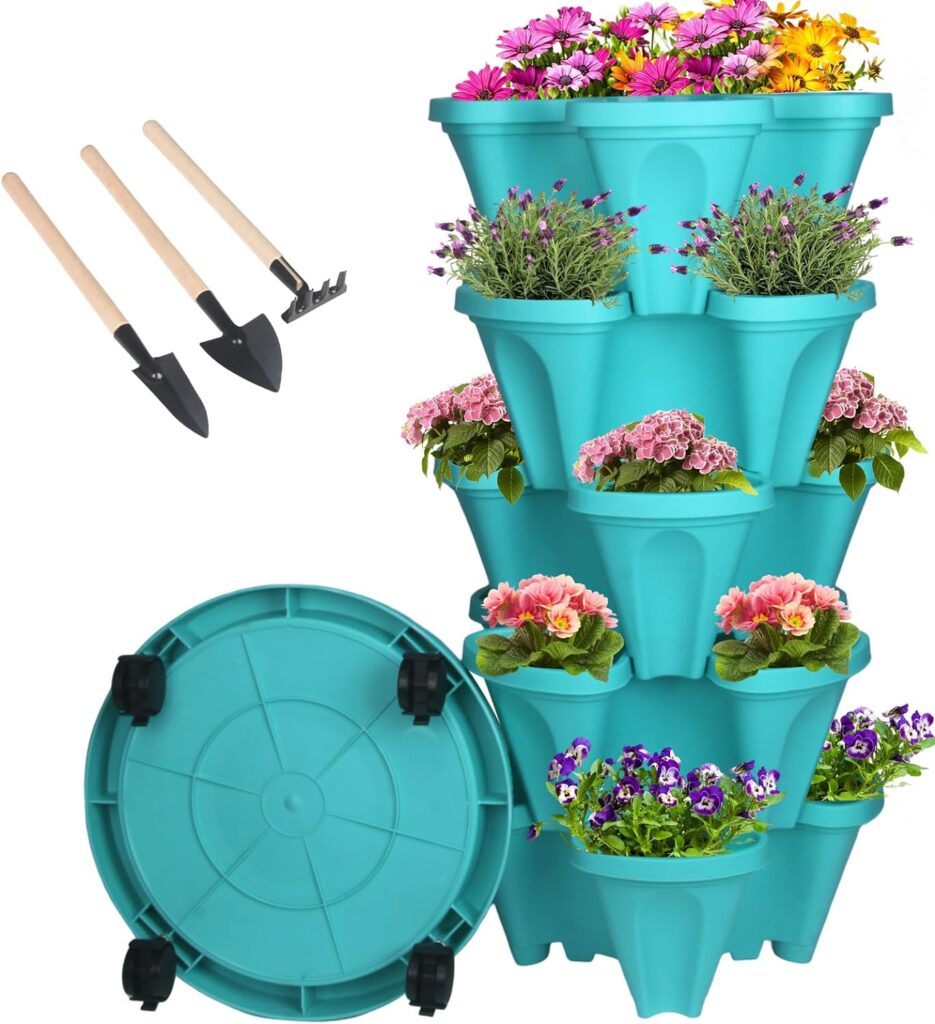
Vertical multi-tier stackable planters are a space-saving solution for container gardening, allowing you to grow a variety of plants in a limited footprint. These planters are essentially modular units that stack on top of each other, creating a vertical garden tower.
Here’s a breakdown of the key features:
- Modular Design: These planters come in individual tiers, typically made of plastic or lightweight metal. Each tier has its own planting area and connects to the tiers above and below it.
- Stackable Tiers: You can customize the height of your vertical garden by adding or removing tiers. This allows you to adjust the planter’s size to fit your available space and desired plant selection.
- Water Distribution System: Some planters have a built-in water distribution system. This system allows you to water the top tier, and the water trickles down through the tiers, hydrating all the plants below.
Benefits of Vertical Multi-Tier Stackable Planters:
- Space Saving: This is the most significant benefit. They allow you to grow a significant amount of plants in a small vertical area, ideal for balconies, patios, or even indoors with limited floor space.
- Versatility: These planters can accommodate a wide variety of plants, from herbs and leafy greens to strawberries, succulents, and even small flowering plants.
- Improved Accessibility: The tiered design makes it easier to tend to plants at different heights, eliminating excessive bending or reaching.
- Aesthetics: Vertical planters can add a unique and visually appealing element to your space. They can create a living wall or a vertical herb garden, adding greenery and life to your surroundings.
Things to Consider:
- Watering: Even with a water distribution system, some models may require individual watering for the top or bottom tiers depending on the design. Monitor moisture levels in each tier to ensure even watering.
- Sunlight Exposure: Since plants on lower tiers receive filtered light from above, choose plants with varying light requirements to ensure all tiers receive sufficient light.
- Drainage: Ensure each tier has adequate drainage holes to prevent waterlogging and root rot. Some models may require adding drainage holes yourself.
- Stability: Taller stacks may require additional support, especially in windy conditions. Look for planters with a wide base or consider anchoring them to a wall for stability.
- Material: Plastic is lightweight and affordable but may not be as aesthetically pleasing as metal options. Metal planters can be sturdier but might be heavier and more expensive.
Overall, vertical multi-tier stackable planters are a great way to maximize your growing space and create a beautiful vertical garden. Their modularity, versatility, and space-saving design make them a popular choice for urban gardeners and those with limited space. However, consider the watering needs, light distribution, and potential stability requirements before choosing this option.
9. Garden Raised Bed Kit: Multi Elevated Planter Boxes with Drainage Holes – A Functional and Versatile Option
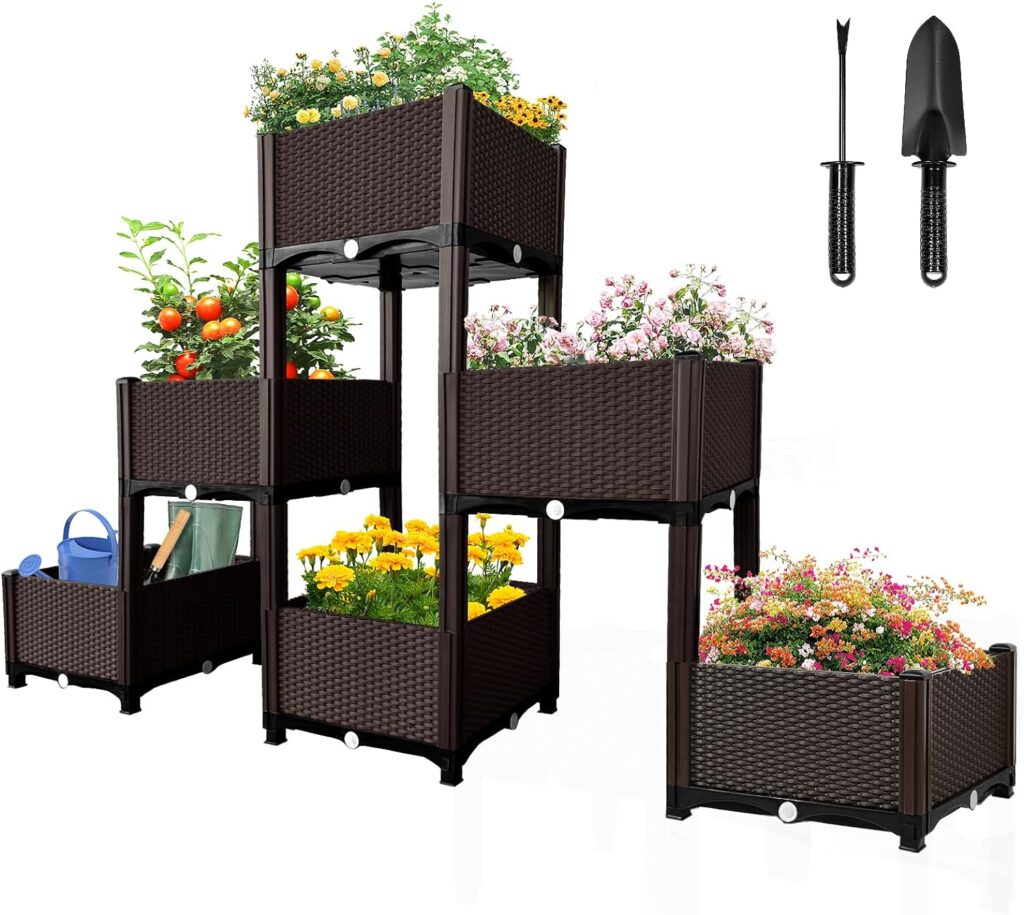
This type of container gardening idea offers a practical and versatile solution for growing your favorite plants in a raised bed format. It combines the benefits of raised beds with multiple individual planter boxes, creating a dedicated growing space with easy customization.
Here’s a breakdown of the key features:
- Raised Bed Design: Similar to traditional raised garden beds, this kit provides elevated planter boxes. This elevation offers several advantages:
- Improved Drainage: Drainage holes in each box allow excess water to drain freely, preventing root rot, a common problem in container gardens.
- Better Soil Temperature: The raised bed can warm up faster in the spring and retain heat better, beneficial for some plants, especially those preferring warmer soil temperatures.
- Reduced Soil Compaction: The raised design helps prevent soil compaction, which can hinder root growth and plant health.
- Easier Access: The elevated boxes make planting, tending to, and harvesting your plants easier, especially for those with bending or kneeling difficulties.
- Multi-Box Design: These kits come with multiple individual planter boxes within the raised bed frame. This allows you to:
- Grow Different Plants: Plant a variety of vegetables, herbs, flowers, or even small shrubs in separate boxes, customizing your mini garden.
- Control Plant Spacing: The individual boxes allow for better control over plant spacing, ensuring each plant receives adequate room for growth.
- Succession Planting: Use the different boxes for succession planting, where you plant crops with different harvesting times throughout the season.
- Kit Components: Garden raised bed kits with multi-planter boxes typically include:
- Pre-cut Panels: These panels, often made from wood, plastic, or metal, form the frame of the raised bed and individual planter boxes. The kit usually comes with instructions for easy assembly.
- Hardware: Screws, nuts, or bolts are provided for fastening the panels together.
- Drainage Holes: Each planter box should have pre-drilled drainage holes to prevent waterlogging.
Benefits of Garden Raised Bed Kits with Multi-Planter Boxes:
- Versatility: These kits cater to a variety of gardening needs. You can grow a diverse selection of plants with the individual boxes and customize your mini garden layout.
- Improved Plant Health: The raised bed design promotes better drainage, soil temperature, and easier access, all contributing to healthier plants.
- Space Saving: While offering multiple planting areas, these kits can be more space-efficient than individual raised beds for each plant type.
- Easy Assembly: Most kits are designed for quick and straightforward assembly, often requiring no special tools.
- Organized Appearance: The raised bed and individual boxes create a clean and organized look in your garden, adding a touch of modern style.
Things to Consider:
- Material: Choose a material that suits your budget, aesthetic preferences, and desired level of maintenance (e.g., wood requires more maintenance than plastic).
- Size and Configuration: Consider the overall size of the kit and the number of planter boxes to fit your available space and desired planting scheme.
- Drainage Holes: Ensure each planter box has adequate drainage holes. Some kits may require drilling additional holes if needed.
- Sun Exposure: Position the raised bed where your plants will receive the appropriate amount of sunlight throughout the day.
- Soil Quality: Fill the planter boxes with high-quality potting mix suitable for your chosen plants.
Garden raised bed kits with multi-planter boxes offer a functional and versatile option for container gardening. Their modular design, ease of use, and ability to grow a variety of plants in a dedicated space make them a popular choice for both novice and experienced gardeners.
10. Potato Grow Bags with Flap, Planter Pot with Handles and Harvest Window: Convenience Meets Efficiency for Growing Potatoes
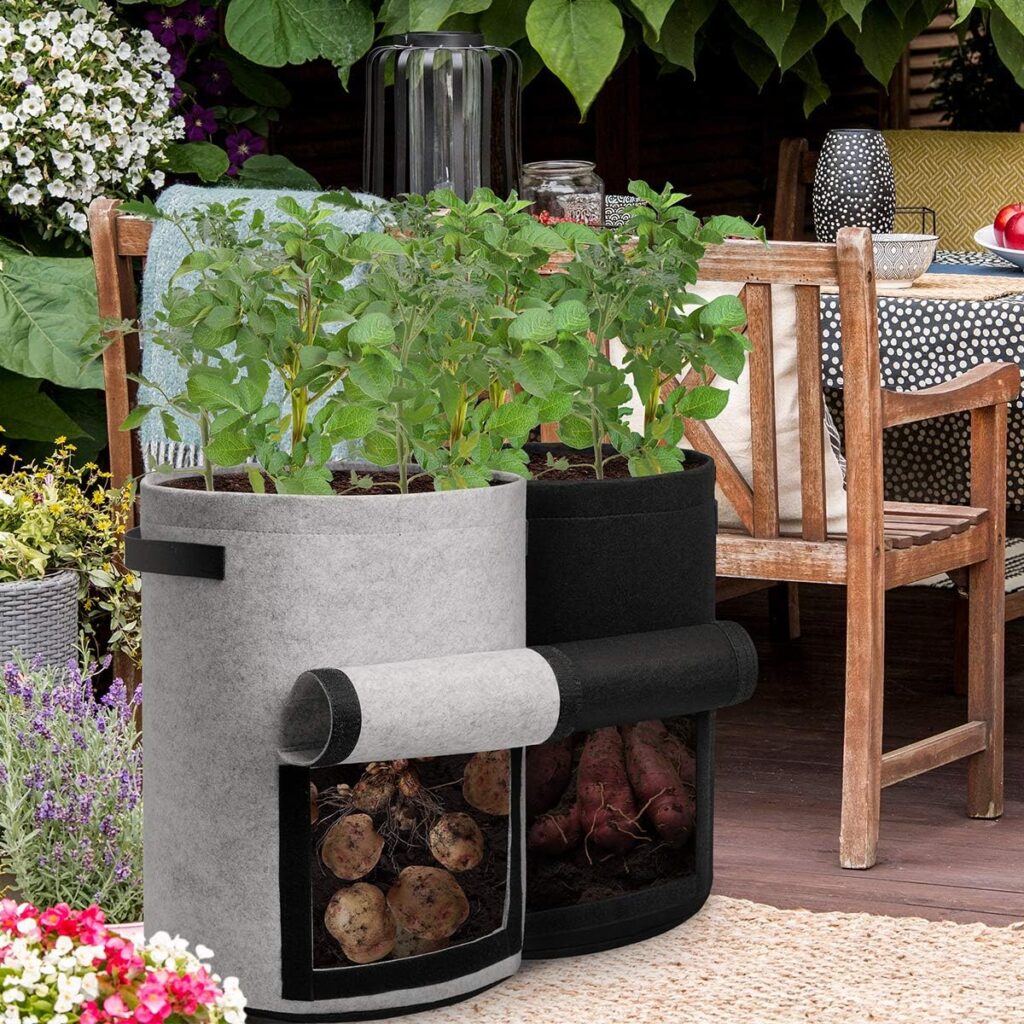
Potato grow bags with a flap, planter pot with handles, and harvest window offer a unique and user-friendly approach to growing potatoes in containers. These innovative bags combine the benefits of container gardening with features specifically designed for growing delicious potatoes.
Here’s a breakdown of the key features:
- Fabric Grow Bag: Made from breathable, non-woven fabric, these bags provide several advantages:
- Airflow and Drainage: The fabric allows for proper air circulation around the potato tubers, preventing rot and promoting healthy growth. It also allows excess water to drain freely.
- Lightweight and Portable: The fabric construction makes them lightweight and easy to move around your garden or patio as needed.
- Flap Design: A key feature of these bags is a built-in flap on the side. This flap allows for easy access to your growing potatoes:
- Monitoring Growth: You can easily peek through the flap to check on the size and development of your potatoes without disturbing the root system.
- Selective Harvesting: The flap allows you to harvest potatoes as needed throughout the growing season without uprooting the entire plant.
- Planter Pot with Handles: These bags often incorporate handles on the sides, making them even more convenient:
- Easy to Maneuver: The handles allow for easy lifting and moving of the grow bag, even when filled with soil and growing potatoes.
- Positioning Flexibility: The handles make it easier to position the bag in your desired location, whether on a balcony, patio, or sunny corner of your garden.
- Harvest Window: Some models may include a transparent window on the side of the bag. This window offers an additional way to:
- Monitor Growth: Visually track the development of your potatoes without needing to open the flap.
- Harvest Readiness: The window might allow you to see the size and maturity of the potatoes, helping determine when they are ready for harvest.
Benefits of Potato Grow Bags with Flap, Handles, and Harvest Window:
- Convenience: The flap design allows for easy monitoring and selective harvesting, reducing the need to disturb the entire plant.
- Space-Saving: These grow bags are ideal for growing potatoes in limited spaces like balconies or patios.
- Healthy Growth: The breathable fabric promotes good air circulation and drainage, preventing issues like root rot, common with traditional potato planting.
- Lightweight and Portable: The fabric construction and handles make them easy to move and position in your garden.
- Visual Monitoring: The flap and harvest window (if included) allow you to keep an eye on your potato growth without disturbing the plant.
Things to Consider:
- Size: Select a bag size appropriate for the number of potato plants you intend to grow.
- Soil Quality: Use a well-draining potting mix suitable for potatoes when filling the bag.
- Watering Needs: Fabric bags may dry out faster than traditional pots, so monitor moisture levels and water regularly.
- Support for Vines: Potato plants can develop long vines. Consider adding a stake or trellis for support within the bag, especially for taller varieties.
- Sun Exposure: Ensure the bag receives sufficient sunlight throughout the day for optimal potato growth.
Overall, potato grow bags with a flap, planter pot with handles, and harvest window offer a convenient and efficient way to grow potatoes in containers. Their innovative design features make them a great option for novice and experienced gardeners alike, especially those with limited space.
11. Raised Garden Bed with Greenhouse Frame and 3 Covers: A Multi-Season Growing Oasis
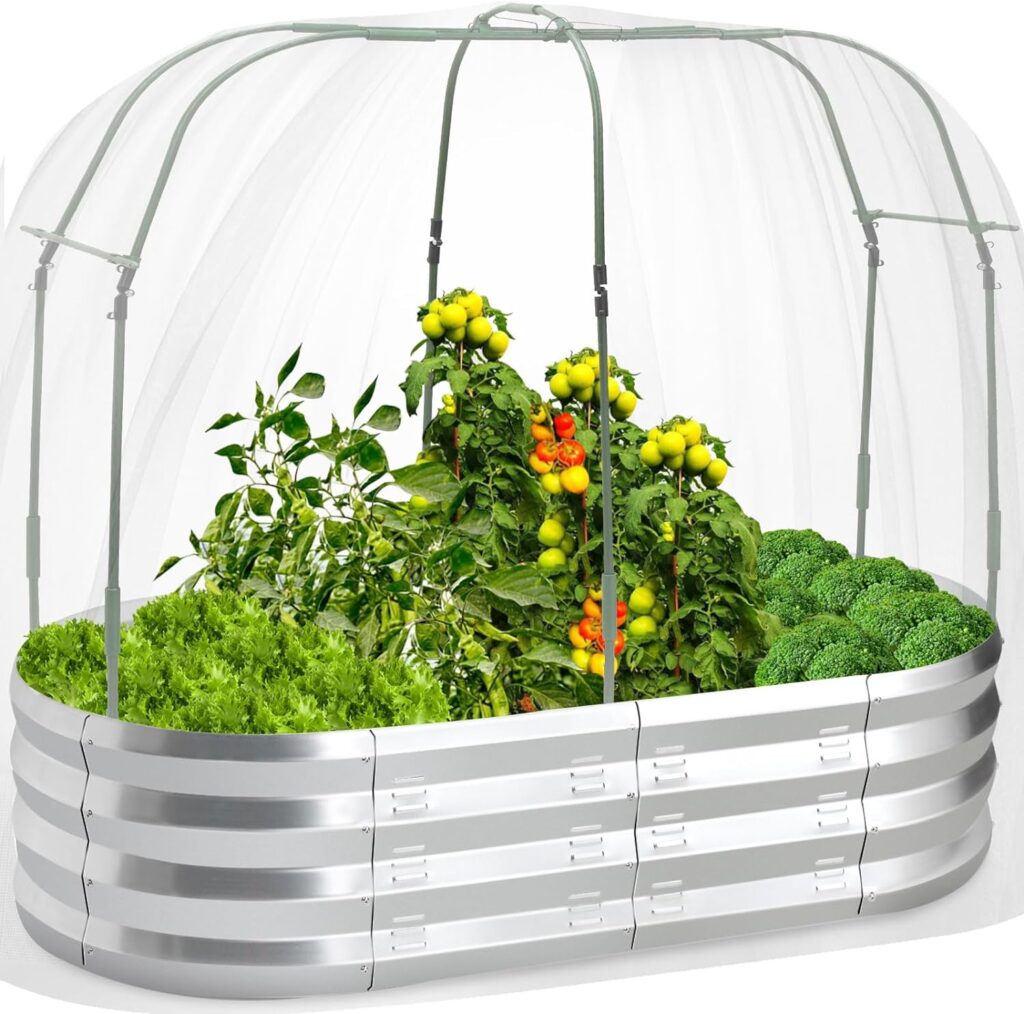
This container gardening concept combines a raised garden bed with a versatile greenhouse frame and three different covers, offering a unique solution for extending your growing season and protecting your plants year-round.
Here’s a breakdown of the key features:
- Raised Galvanized Metal Oval Planter Box:
- Material: This oval-shaped raised bed is constructed from galvanized metal, known for its durability and resistance to rust and corrosion.
- Elevated Design: The raised bed offers several benefits:
- Improved Drainage: Drainage holes allow excess water to drain freely, preventing root rot.
- Better Soil Temperature: The metal can absorb heat from the sun, potentially warming the soil in cooler weather.
- Reduced Soil Compaction: The raised design helps prevent soil compaction, promoting healthy root growth.
- Easier Access: The elevation makes planting, tending to, and harvesting your plants more comfortable.
- Greenhouse Frame:
- Structure: A lightweight frame made from metal or plastic sits atop the raised bed. It provides support for the various covers.
- Assembly: These frames are typically designed for easy assembly, often requiring no special tools.
- Three Covers:
- Greenhouse Cover: This clear plastic cover creates a mini greenhouse environment, trapping heat and humidity to extend the growing season in cooler climates.
- Garden Shade Cover: A mesh shade cover helps protect plants from intense sunlight and heat stress during hot summer months.
- Garden Fine Mesh Netting: This fine mesh netting provides protection against insects and pests like birds or crawling insects, safeguarding your plants.
Benefits of a Raised Garden Bed with Greenhouse Frame and 3 Covers:
- Season Extension: The greenhouse cover allows you to start seeds earlier in spring and potentially grow vegetables or herbs even in cooler temperatures.
- Sun Protection: The shade cover protects plants from scorching summer sun and prevents heat stress.
- Pest Protection: The fine mesh netting safeguards your plants from insect damage and unwanted visitors.
- Versatility: The three covers offer year-round protection and climate control for your plants, adapting to different weather conditions.
- Space Saving: This all-in-one system provides a dedicated growing space with various climate control options in a compact design.
Things to Consider:
- Size: Choose a size that accommodates your desired number of plants and fits comfortably in your designated space.
- Ventilation: Ensure proper ventilation, especially when using the greenhouse cover. Open the cover on mild days to prevent overheating.
- Climate: Consider your local climate when choosing which cover to use. The shade cover might be more beneficial in hot climates, while the greenhouse cover is more valuable in cooler areas.
- Wind Stability: The frame and covers might require additional anchoring in windy locations.
- Metal Material: While galvanized metal offers durability, it can heat up significantly in hot climates. Monitor soil temperature, especially for heat-sensitive plants.
In a nutshell, a raised garden bed with a greenhouse frame and 3 covers provides a versatile and functional solution for container gardening. This multi-season growing system allows you to nurture your plants year-round, offering protection from various weather elements and pests. It’s a great option for gardeners who want to extend their growing season or create a controlled growing environment in a limited space.
12. Cement Succulent Planter Pot with Bamboo Tray Set
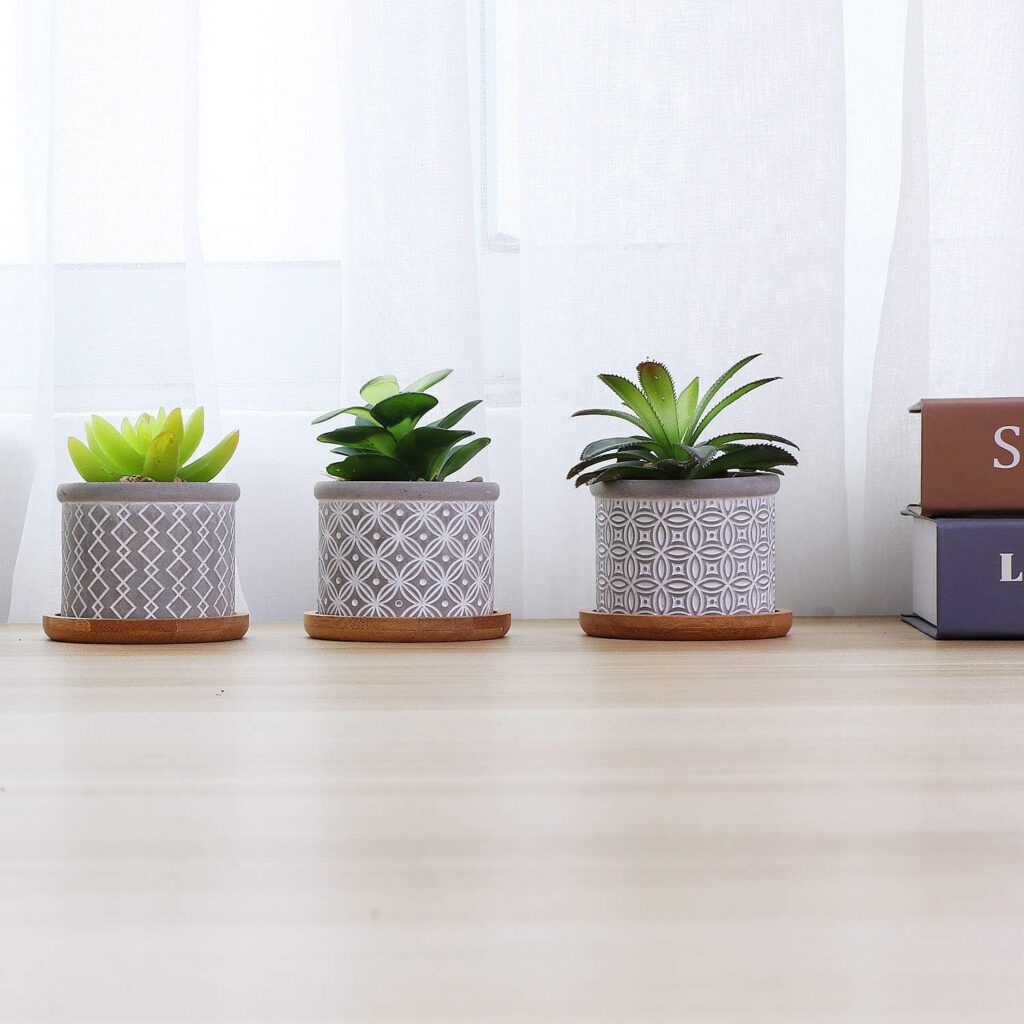
A cement succulent planter pot with a bamboo tray set is a stylish and popular choice for container gardening. These planters offer a modern aesthetic that complements various décor styles, and the natural materials of cement and bamboo create a visually pleasing combination.
Components:
- Cement Planter Pot:
- Made of cement, these pots offer a sleek and contemporary look.
- Cement is a durable material that can withstand outdoor elements reasonably well, although special care may be required in freezing climates.
- Available in various shapes and sizes, allowing you to choose planters that fit your succulent varieties and aesthetic preferences.
- Drainage holes are typically present in the bottom of the pot to prevent waterlogging, which can be detrimental to succulents.
- Bamboo Tray:
- Made from bamboo, a sustainable and natural material that complements the cement pot.
- The tray catches any excess water that drains from the pot, protecting your surfaces from water damage.
- Bamboo trays add a touch of warmth and natural style to the overall look.
- Some bamboo trays may have a drainage hole to allow excess water to drain completely, preventing tray waterlogging.
Benefits of Cement Succulent Planter Pots with Bamboo Trays:
- Stylish Design: The combination of cement and bamboo creates a modern and minimalist aesthetic that complements various décor styles.
- Durability: Cement pots are sturdy and can last for many years with proper care. Bamboo is a naturally durable material as well.
- Portability: The lightweight nature of both cement and bamboo makes these planters easy to move around your home or garden.
- Drainage: Drainage holes in the pot and potentially the tray help prevent overwatering, which is a major threat to succulents.
- Material Versatility: Cement pots come in various shapes and sizes, while bamboo trays offer a natural and sustainable element.
Things to Consider:
- Weight: While lighter than traditional clay pots, cement planters can still have some weight, especially in larger sizes. Consider this when choosing a location and moving them around.
- Drainage: Ensure proper drainage by checking for holes in both the pot and the tray. If the tray doesn’t have a drainage hole, empty any accumulated water to prevent tray waterlogging.
- Porous Material: Cement can be porous and may absorb moisture from the soil. Monitor watering needs carefully to avoid underwatering or overwatering your succulents.
- Winter Care: In colder climates, excess moisture in cement pots can freeze and crack the pot. If using outdoors in freezing temperatures, consider using the planter indoors during the winter or taking steps to protect it from freezing.
Overall, cement succulent planter pots with bamboo trays are a stylish and functional option for container gardening. Their modern design, durability, and portability make them a popular choice for displaying your succulents indoors or outdoors.
13. Window Box Planters
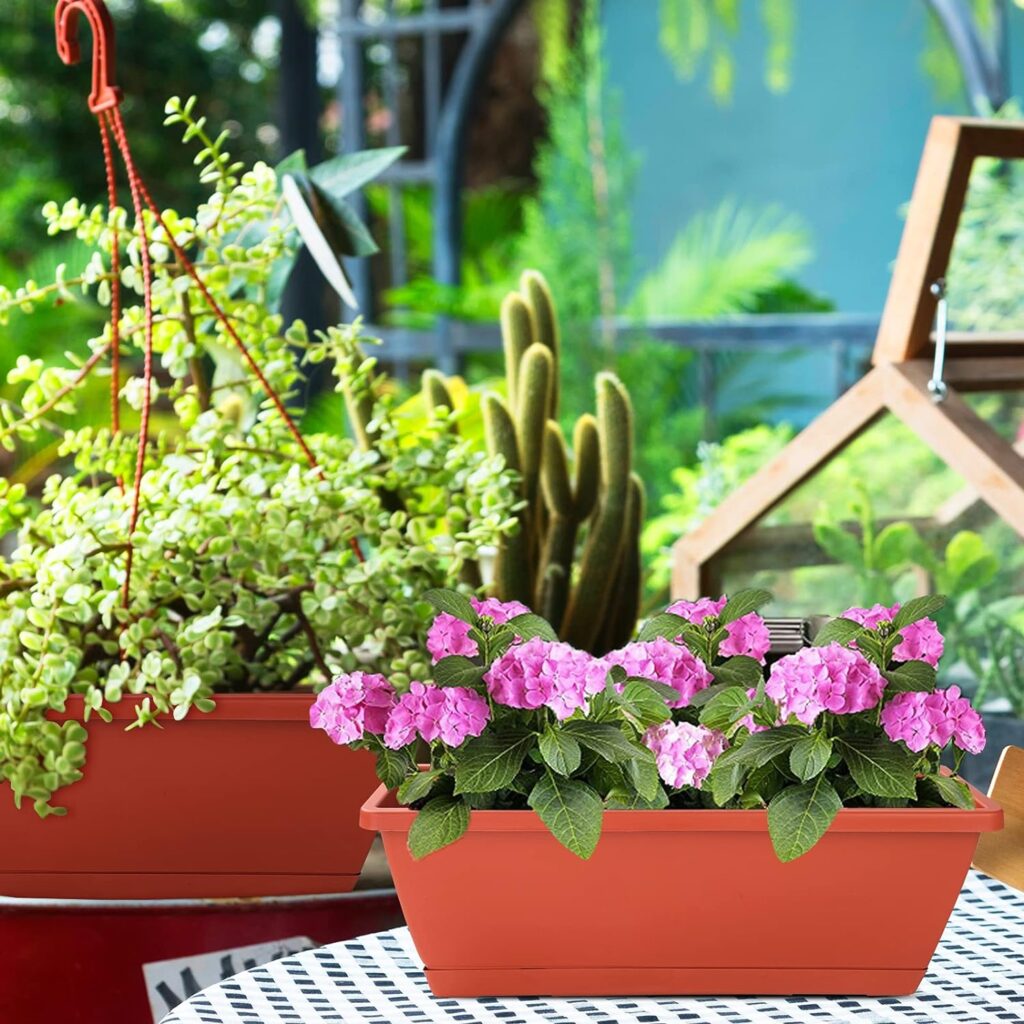
Window box planters are long, rectangular containers specifically designed to be attached to window sills or railings on the exterior of your home. They come in a variety of sizes, materials, and colors, allowing you to create a beautiful and functional container garden right outside your window.
Typical Components of Window Box Planters:
- Material: Window boxes are most commonly made of:
- Plastic: Lightweight, affordable, and available in various colors. Plastic window boxes are easy to maintain but may not be as aesthetically pleasing as other options.
- Cedar or Redwood: These naturally rot-resistant woods offer a classic and elegant look. Cedar and redwood window boxes are durable but require occasional maintenance to protect against weathering.
- Vinyl: A popular option that provides the look of wood with lower maintenance requirements. Vinyl window boxes are weather-resistant and easy to clean.
- Wrought Iron: The most durable option, offering a sophisticated and timeless look. Wrought iron window boxes are heavy and can be expensive.
- Drainage Holes: Essential for preventing waterlogging and root rot. Most window boxes come with pre-drilled drainage holes. If not, ensure proper drainage by creating some yourself.
- Liners: Optional liners made of plastic or fabric can be used to improve moisture retention and reduce the mess of soil spilling out of drainage holes. However, liners can also restrict drainage so ensure they have holes that line up with the drainage holes in the planter.
Benefits of Window Box Planters:
- Space Saving: They allow you to create a garden even if you have limited outdoor space.
- Visual Appeal: Window boxes add a pop of color and life to the exterior of your home.
- Versatility: You can grow a wide variety of plants in window boxes, including vegetables, herbs, flowers, and even small shrubs.
- Convenience: Easy to access for planting, tending to, and harvesting your plants.
Things to Consider When Choosing Window Box Planters:
- Size: Select a size that fits comfortably on your window sill or railing without blocking the window or creating an unbalanced look.
- Material: Consider the aesthetics, weight, durability, and maintenance requirements of the different materials.
- Drainage: Ensure the window box has adequate drainage holes to prevent waterlogging.
- Sun Exposure: The amount of sunlight your window receives will influence the types of plants you can grow successfully in the window box.
- Weight: When filled with soil and plants, window boxes can become heavy. Consider the weight capacity of your window sill or railing.
Window box planters are a versatile and attractive way to add greenery and beauty to your home’s exterior. With careful planning and plant selection, you can enjoy a thriving container garden right outside your window.
14. Terracotta Pots with Saucers: Classic Charm for Succulents and Cacti
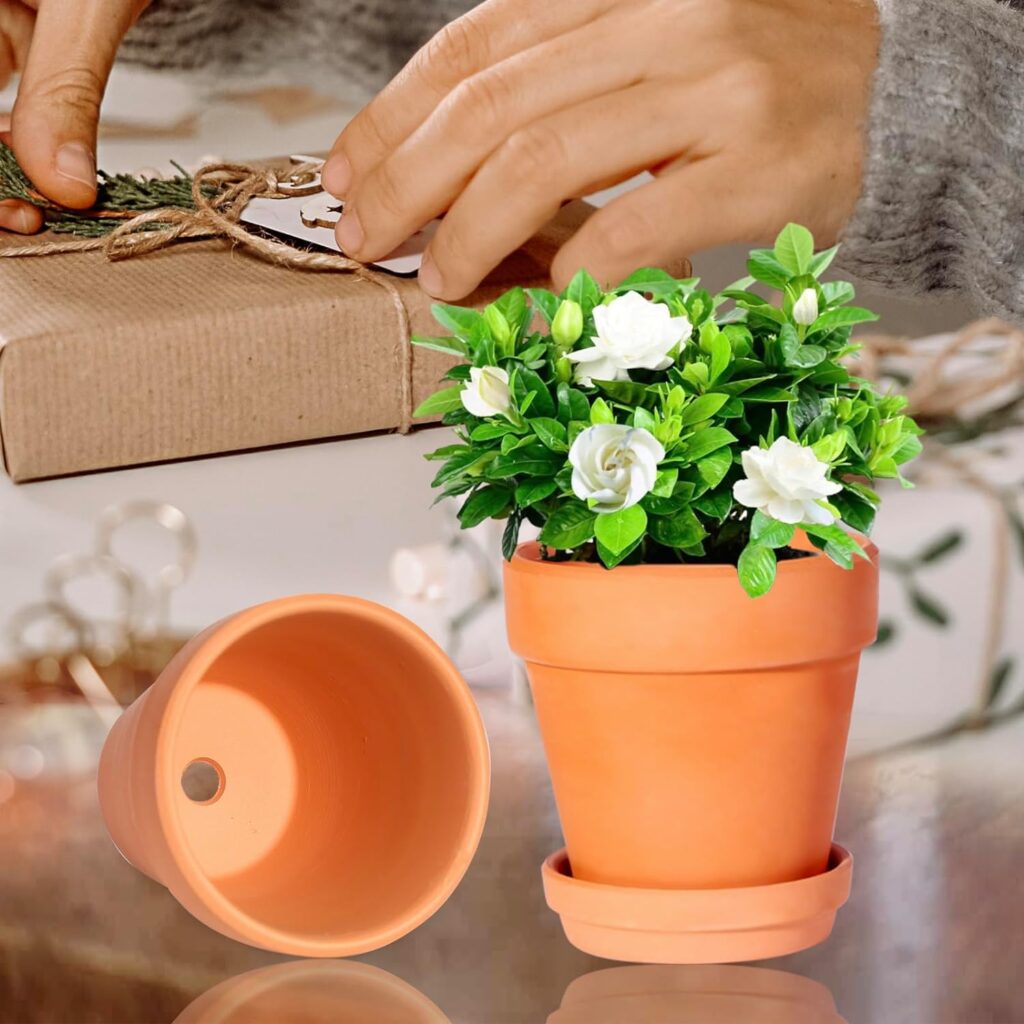
Terracotta pots with saucers are a timeless and practical choice for container gardening, particularly for succulents and cacti. These planters offer a natural aesthetic, excellent breathability, and functionality that makes them ideal for these low-maintenance plants.
Here’s a breakdown of the key features:
- Terracotta Material:
- Made from baked clay, terracotta pots offer a classic and rustic charm that complements various décor styles.
- The natural clay material is breathable, allowing for good air circulation around the roots. This is crucial for succulents and cacti, which thrive in dry environments and are prone to rot with excessive moisture.
- Terracotta pots are relatively affordable and readily available in various shapes and sizes, allowing you to choose planters that suit your specific plants and aesthetic preferences.
- Drainage Holes:
- A crucial feature for succulents and cacti. Drainage holes prevent water from accumulating around the roots, which can lead to rot.
- Most terracotta pots come with pre-drilled drainage holes.
- Saucers:
- Typically sold as a set with the pot, saucers are designed to catch excess water that drains from the pot.
- While some may find the saucers aesthetically pleasing, their primary function is to protect surfaces from water damage.
- For succulents and cacti, it’s essential to empty the saucer regularly to avoid the plant sitting in water.
Benefits of Terracotta Pots with Saucers for Succulents and Cacti:
- Breathability: The terracotta material promotes air circulation around the roots, preventing moisture buildup and rot, a major concern for succulents and cacti.
- Drainage: Drainage holes ensure excess water escapes, further protecting your plants from root rot.
- Affordability and Availability: Terracotta pots are a budget-friendly option readily available in various sizes and styles.
- Classic Aesthetics: The natural clay material offers a timeless and versatile look that complements various home décor styles.
- Porosity: Terracotta’s slightly porous nature allows for some gradual moisture release, potentially reducing watering frequency in hot climates.
Things to Consider:
- Porosity: While beneficial in hot climates, the porosity of terracotta can also lead to faster soil drying. Be mindful of watering needs, especially in dry or hot weather.
- Weight: Terracotta pots can become heavy, especially in larger sizes, when filled with soil and plants. Consider this when choosing a location and moving them around.
- Winter Care: Terracotta pots can be susceptible to cracking in freezing temperatures. If using outdoors in cold climates, provide winter protection or bring the pots indoors for the winter season.
- Saucer Use: Empty the saucer regularly to prevent water from accumulating around the pot and potentially harming the plant.
Terracotta pots with saucers are a classic and practical container gardening option for succulents and cacti. Their breathability, drainage features, affordability, and timeless aesthetics make them a popular choice for both novice and experienced gardeners.
Conclusion
This exploration of 14 stunning container garden ideas has hopefully sparked your creativity and provided inspiration for your own green oasis. Remember, container gardening allows for endless customization. Don’t be afraid to experiment with different plant combinations, container styles, and color schemes to create a space that reflects your personal taste.
Bonus Tips for Container Gardening Success:
- Choosing the Right Pot: Select a pot with drainage holes to prevent waterlogging. The size of the pot should be appropriate for the mature size of the plant.
- Proper Drainage: Ensure your containers have adequate drainage holes to prevent root rot. You can add a layer of gravel to the bottom of the pot to improve drainage.
- Watering Techniques: Water your container gardens regularly, especially during hot weather. The frequency will depend on the plant variety, pot size, and climate. Avoid overwatering, as this can be detrimental to plant health.
- Fertilizing: Regularly fertilize your container plants according to the specific needs of the chosen plants. Opt for a balanced fertilizer formulated for container gardens.
With a little planning and care, you can create a thriving and beautiful container garden that will transform your space and bring you joy for seasons to come.

